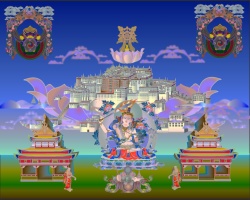Perennialist and Buddhist Views of Reality
You have asked me to explain the basic differences between a Christian Perennialist view of Reality and that of Mahayana Buddhism. Now,that's a tall order. I can do no more than indicate what some of the major issues are, as I see them. For one thing neither of these views can be neatly pinned down simply because different adherents and different schools have differing views. But if I write about them at a high level, I may be able to talk about some of the differences without getting so deeply into details as to bog down the discussion. So here goes.
To me the main difference is that Christian Perennialism is monotheistic and the mainstream of Mahayana Buddhism is non-theistic. Right away a critic may wish to bring up all the many deities in the Tibetan tradition. But within this tradition, these deities are not seen as self-existent beings. They are seen as personifications of aspects of our own minds. So it is not accurate to say that Tibetan Buddhism is theistic in the same way as Christianity.
Now the issue of theism versus non-theism leads to very different views about the nature of Reality and about the relationship between the Reality and this world. I am going to take the emanationist view of philosphia perennis, or Neo-Platonism, which is more or less equivalent, as the basis for my discussion of how a theistic view deals with these issues.
In the perennialist metaphysic, the universe is envisioned as a Great Chain of Being. That is to say, starting from the pure undifferentiated Absolute, the universe descends through levels of Being becoming more and more coarse and material as it descends, until it terminates in the physical, material world, of rocks, trees, soil and so on. So we have the Absolute, then the personal God, the angelic hierarchies, the galaxies, the solar system, the planets, Man in the center, then the inanimate creation. There are many more levels, but this will give you an idea. Each level "participates" in the levels above it by a kind of interpenetration. So this metaphysic wants to say that the levels are not completely discontinous. The lower levels are said to mirror the higher levels. So for instance, Man is said to be the image of God on earth. And every positive phenomena is said to have its archetype in God. So we have the vision of every positive phenomena as at once itself and at the same time a symbol of a quality that ultimately resides in God as an Idea, Quality, or Virtue. The perennialist hopes to convey, by means of this hierarchy of Being, that there are no abrupt discontinuities in the creation. Each level is linked to the level above and below it by means of an interpenetration of essences that provides a real, ontological link between them. Ultimately, all positive phenomena participate in God to the extent of their capacity and thus reveal him while at the same time hiding him
But this view is not without its difficulties. I will bypass here the main difficulty of Neo-Platonism which was to explain how an Absolute that was One in all respects could ever give rise to two much less the many phenomena which we observe. Christianity thinks it has an answer for this problem in the Trinity. But I don't want to go down that path.
What I want to talk about is the unavoidable fact that in the hierarchical, emanationist view of philsophia perennis, there is always going to be better and worse. As the creation declines from the Absolute and from God, it necessarily becomes worse than him. For God is conceived as Perfect Being. Therefore, anything different from God in any respect is necessarily worse. The perennialist metaphysic although it may say that all positive phenomena contain something of God in that they participate some quality or other of his by their very existence (God gives all things their Being if nothing else.), it cannot avoid the consequence that things are also different from God (else perennialism would be pantheism) and therefore worse than him.
So I submit that the world of phenomena must necessarily take on a somewhat pejorative cast in any theisic view that sees God as perfect and the world as, in some sense different from this God. For as I have said, and as St. Augustine observed, anything that is different from the Perfect is necessarily imperfect. Now that is not necessarily to claim that the world is evil as such. But at the very least it does tend in that direction. In the Christian perennialist view, the creation is envisioned as necessarily a falling away from God or the Good. So the world is viewed as flawed. Therefore, we must not give ourselves fully to to "The World." So in Christian spirituality, there is necessarily a degree of antipathy toward "The World". And this antipathy and the danger that "The World" constitutes require some degree of asceticism and renunciation of "The World".
I want to stop here. In my next post I want to continue by contrasting this Christian perennialist view with a view of Emptiness or Shunyata in the Buddhist Mahayana tradition.

